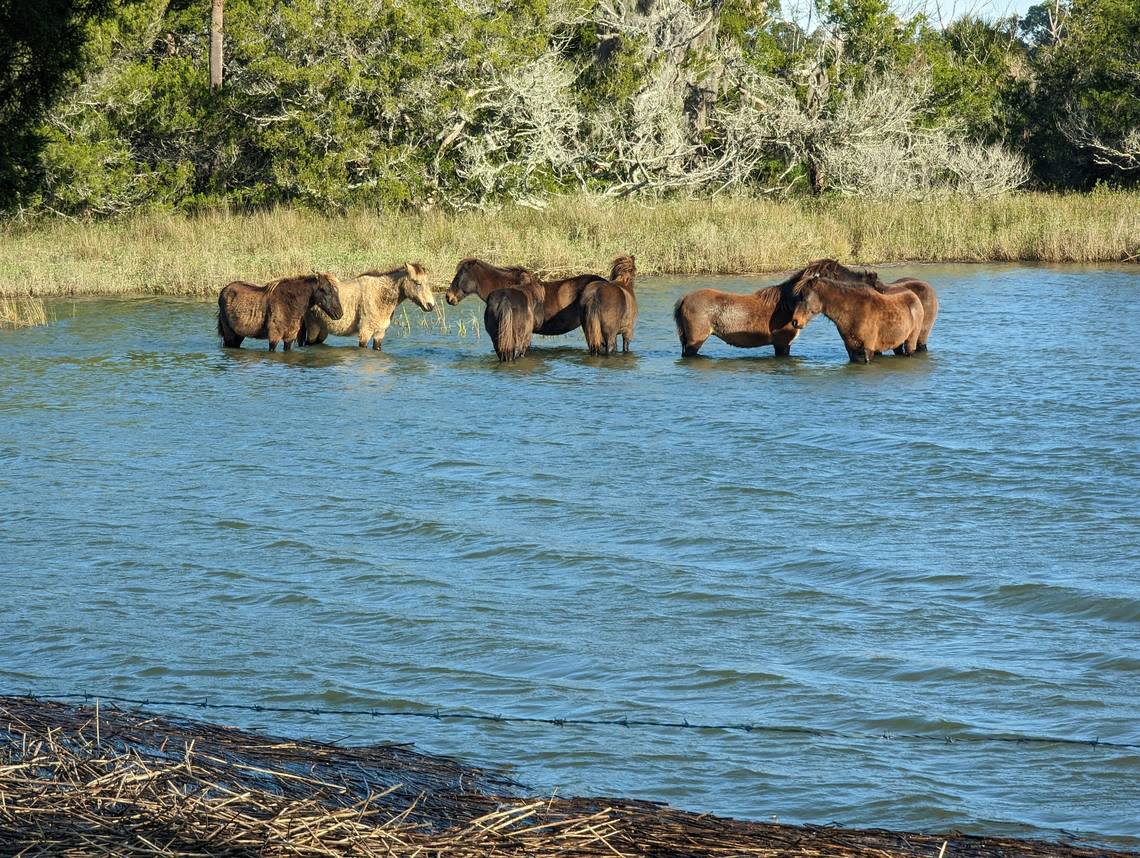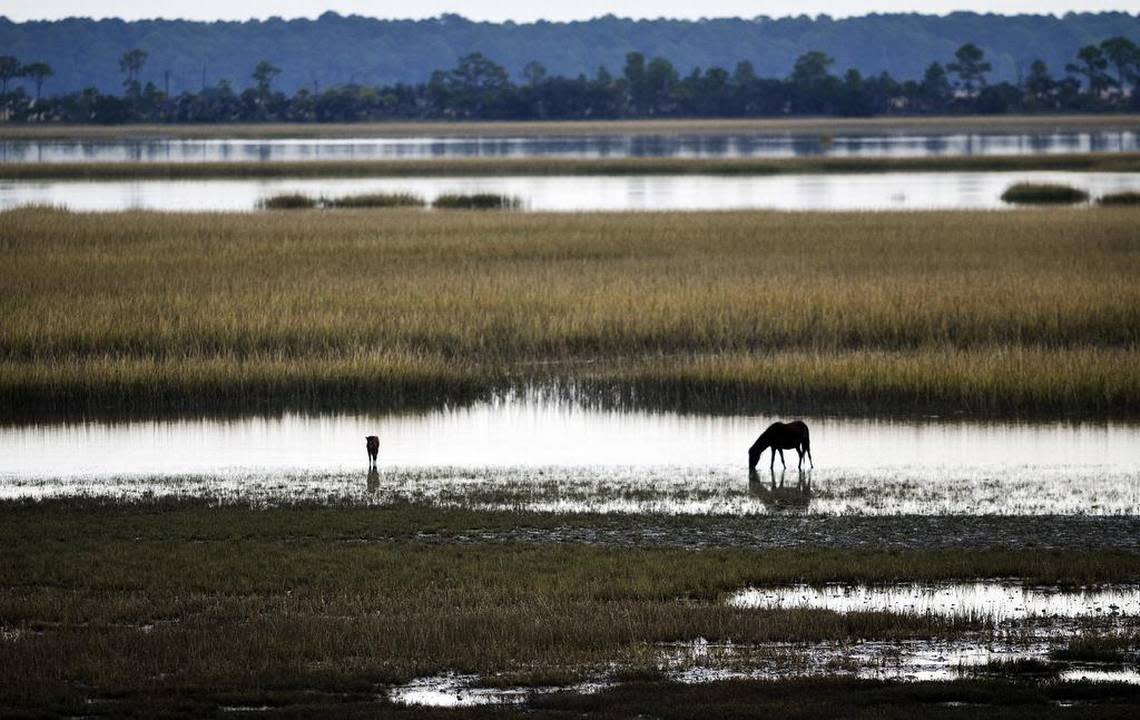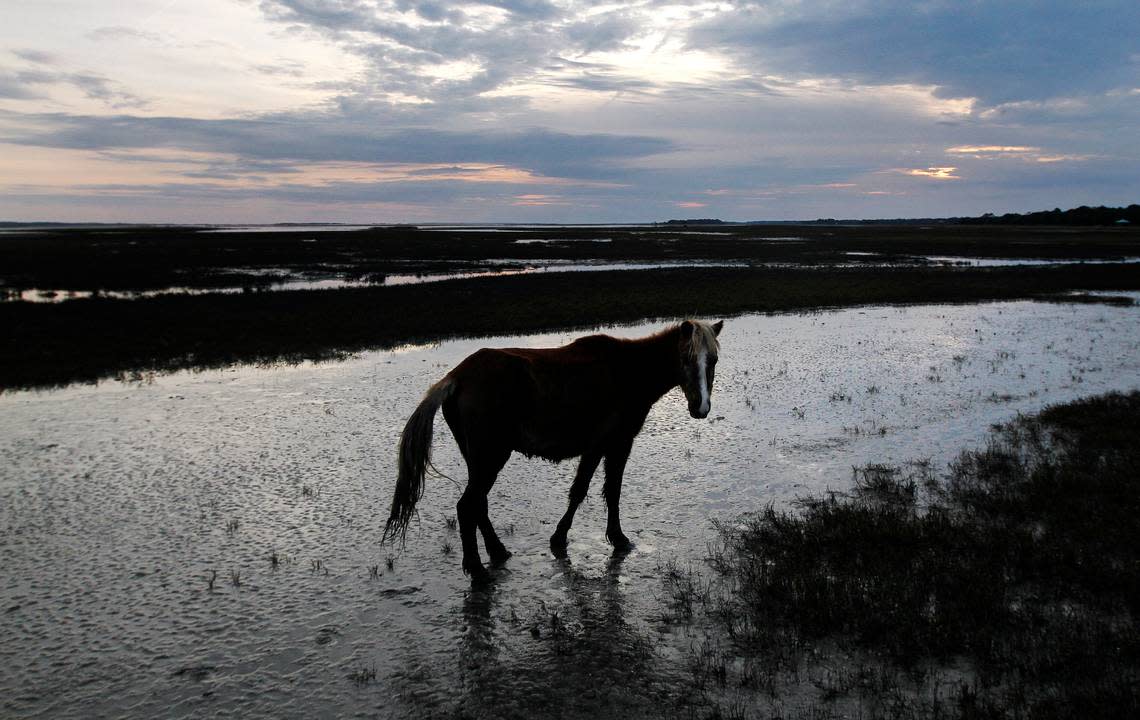St. Helena residents hope to save ‘magical’ wild pony breed that has adapted to SC’s coast
After more than half a century, marsh ponies — a cross between the native Carolina marsh tacky horse and Shetland pony — have adapted to life in the South Carolina Lowcountry.
Today, they roam Little Horse and Horse islands in the Harbor River flats bordering northern St. Helena Island, where they are in tune with the tides, munch on marsh grass and plow through pluff mudd that would sink a bigger horse. Fences keep them from straying too far.
“How magical to see wild horses on the marsh,” says Kate Hamilton Pardee, who remembers waking up to whinnies when she first moved to Little Horse Island. “It’s really an incredible thing when you think about it.”
But the population of the unique coastal South Carolina breed — which has dropped to 8 ponies with no breeding stock remaining in the small herd — is in danger of disappearing without intervention. That reality has spurred residents such as Pardee into action.
They’ve formed Friends of Beaufort County Marsh Ponies, and its mission is to ensure their future by improving care and boosting the population before it’s too late.

“They are the only wild ponies on the shore of South Carolina we’re aware of,” said Venaye Reece McGlashan, a retired veterinarian and resident of Little Horse Island.
As it stands now, the ponies, which look more like little horses than stout Shetland ponies, are largely out of sight on the privately-owned Little Horse Island and a small portion of the abutting Horse Island.
It’s also the goal of the committee to give the public, at some point, more access to them, even if it is from afar via a viewing scope on land it hopes can be acquired.
The ponies, which are semi-feral, would remain on their own in the marshy backwaters of Lowcountry, if the group has its way.
“We don’t want them to be put into a fenced pen,” said McGlashan, “and turned into backyard petting ponies.”
Uncertainty for the marsh ponies isn’t new, said McGlashan, who stepped forward to help manage the herd 8 years ago.
Over the years, hurricanes and development have reduced the amount of available habitat, McGlashan said. In 2014, several escaped, and a pregnant female was struck and killed by a car.
The ponies have been limited to Little Horse Island and Horse Island since the late 1990s and early 2000s. The population was as high as 20 in 2014.
“As things have developed and progressed,” McGlashan said, “they’ve been pushed and pushed into smaller areas.”
But several recent developments, she said, have brought an urgency to securing a future for the peculiar ponies in the wild.
First, Wayne Jernigan of Charlotte, who owns Little Horse Island, which was named after the ponies, is ill, and the family has decided to sell the property. Jernigan has voluntarily overseen the care of the horses and provided hay, feed and fencing.
“The fact that the property will sell,” McGlashan said, “puts the whole care of the ponies up in the air again.”
Also, McGlashan said she and her husband are no longer able to manage the herd. That raises the issue of who will maintain fencing and feed the animals, if the new owner agrees to participate in their care. Although the horses feed mostly on marsh grasses, that’s supplemented with hay and feed, especially during the winter. Group members would like to see a full-time caretaker hired.
Marsh ponies came about when St. Helena Island resident John Henry “Buster” Gay cross-bred a marsh tacky with a Shetland pony in the late 1950s. The marsh tacky, whose genetics are linked to pack horses that Spanish explorers brought in the 1500s, is the state heritage horse of South Carolina.
Today, the remaining ponies really belong to no one, said McGlashan.
Over the years, the isolated ponies have developed interesting characteristics enabling them thrive in South Carolina’s wet and wild Lowcountry, along with shorebirds, eagles, deer, raccoon, mink and dolphins.
“They wait for the tides to change,” Pardee said. “There are some nights they are stuck on the island where they go out there to feed, and they have to be there all night because of the tide. It’s just amazing.”
While larger horses might panic or freeze if they encountered pluff mudd, McGlashan said, the ponies know how to navigate the coastal goo. “They can plow through a fair amount,” she said.

One of the mares is fitted with a tracking device documenting that the herd travels 3 to 6 miles a day. When the bugs are bad, they go to the locations where they can find the best breeze. When the weather is fierce, they can be found in places where they typically shelter.
“They are very tough, very smart,” McGlashan said of the sure-footed marsh ponies. “They have learned to survive in this habitat.”
While they’ve adjusted to people, McGlashan said, the ponies are rarely handled and remain semi-wild. “We let them enjoy being their own little herd.”
A long-term plan to sustain the ponies is in the beginning stages.
But committee members said they can’t develop it without assistance from partner organizations including Beaufort County.
“My own personal mission,” said Pardee, “is to let people in the Lowcountry see them.”
Members of the new committee have had discussions with Beaufort County about the possibility of using Rural and Critical Lands Preservation Program funds to secure property for a viewing platform where the public could watch the ponies through a viewing scope.
McGlashan believes there would be support for using public funds to support the ponies.
“They have been established here for 60 years,” McGlashan said. “So, historically, they really have a place in the history of the island and the Lowcountry here.”

McGlashan also wants to see a breeding plan established.
The current herd has three mares and 5 geldings. Several years ago, the males were sterilized to prevent in-breeding and too much population growth that leads to overgrazing.
At that time, the plan always was to introduce outside but similar bloodlines to the marsh ponies, McGlashan said. But time slipped away, and now the ponies are getting older.
Committee members are investigating the best way to sustain the population. Possibilities include bringing in a small marsh tacky stallion or a pony from an island herd in North Carolina with similar characteristics.
